Abstract
In order to determine whether mammary gland differentiation, which is known to protect this organ from chemically induced carcinogenesis, can be stimulated in virgin rats by administration of a progestagenic agent, medroxyprogesterone acetate (MPA) was given to 300 Sprague-Dawley virgin rats, which at the ages of 45, 55, 65 and 75 days, groups I, II, III and IV respectively, had implanted an MPA pellet of 0.5 mg (low dose-LD) or 5.0 mg (high dose-HD). Pellets were removed after 21 days, and 21 days later five animals per group were killed for evaluation of mammary gland development. The remaining animals received 8 mg 7,12-dimethylbenz(a)-anthracene (DMBA) per 100 g body weight, and were killed after 24 weeks for evaluation of tumour incidence. Both age and treatment affected mammary gland structure and had a significant interaction in the proportion of terminal end buds (TEBs) present. The number of TEBs decreased as a function of age; treatment at both LD and HD did not modify the proportion of TEBs in groups I and III; LD decreased their percentage in group II, and both doses markedly increased TEB percentage in group IV animals. MPA LD treatment did not affect overall tumour and adenocarcinoma incidence although group IV animals developed greater incidences than their respective controls. MPA HD treated rats were 2.45 times more likely to develop tumours than their respective controls. Adenocarcinoma incidence had a significant positive correlation with the percentage of TEBs present. It was concluded that this progestagenic agent did not increase the risk of carcinoma development when administered to virgin rats at the clinical dose used for contraception. However, a 10-fold dose increase resulted in a higher tumorigenic response.
Full text
PDF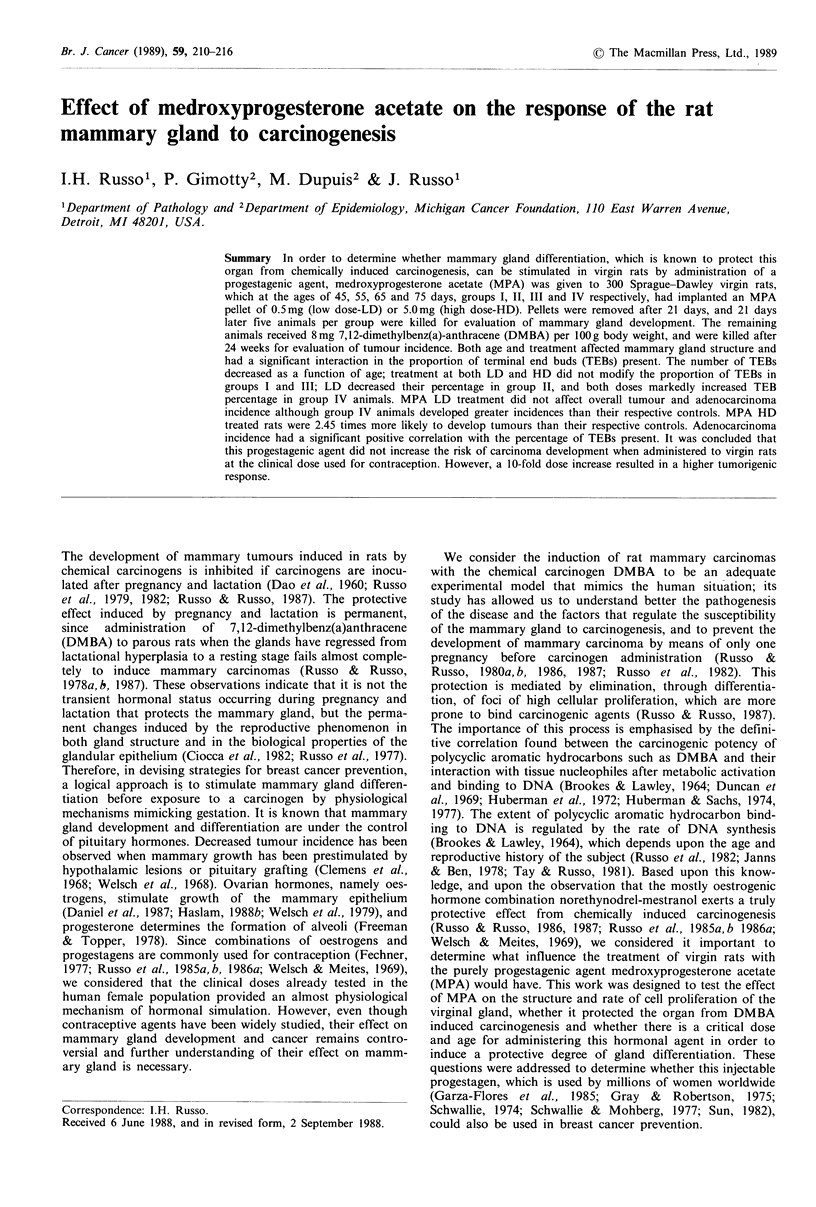
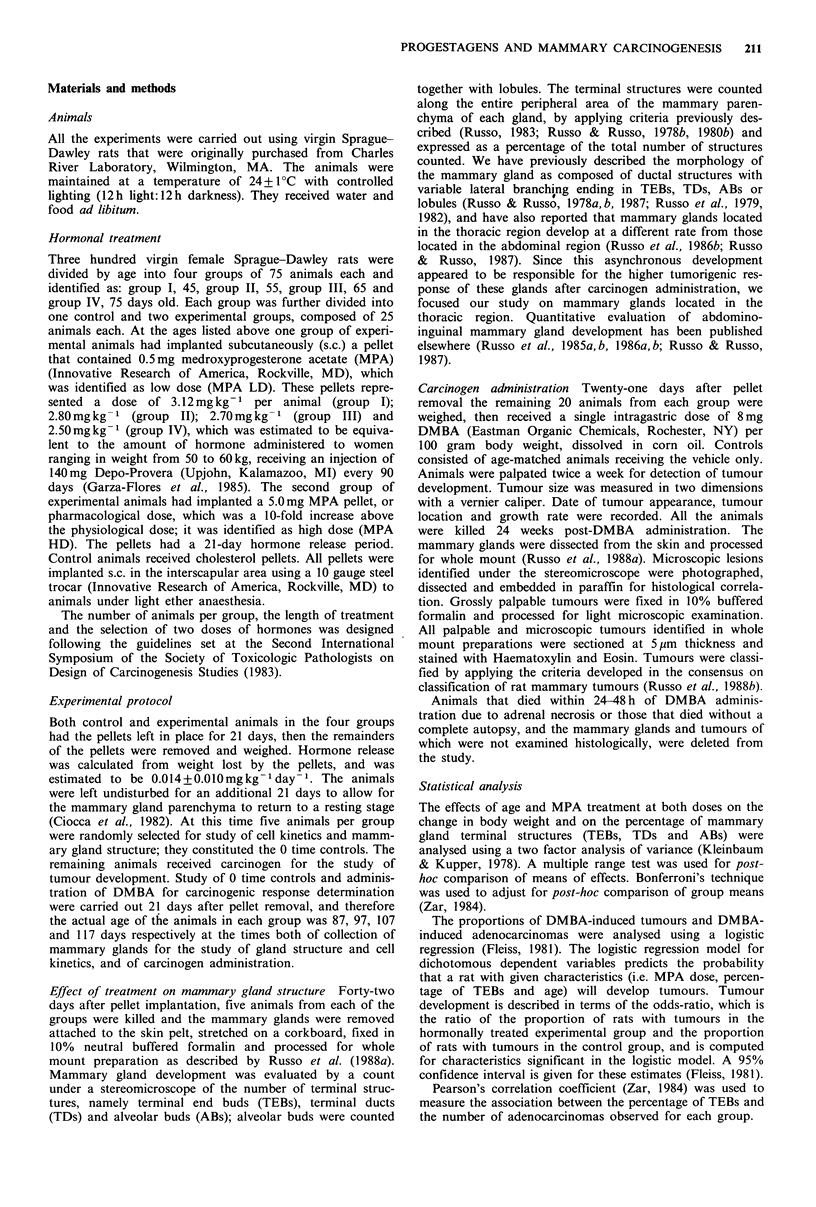
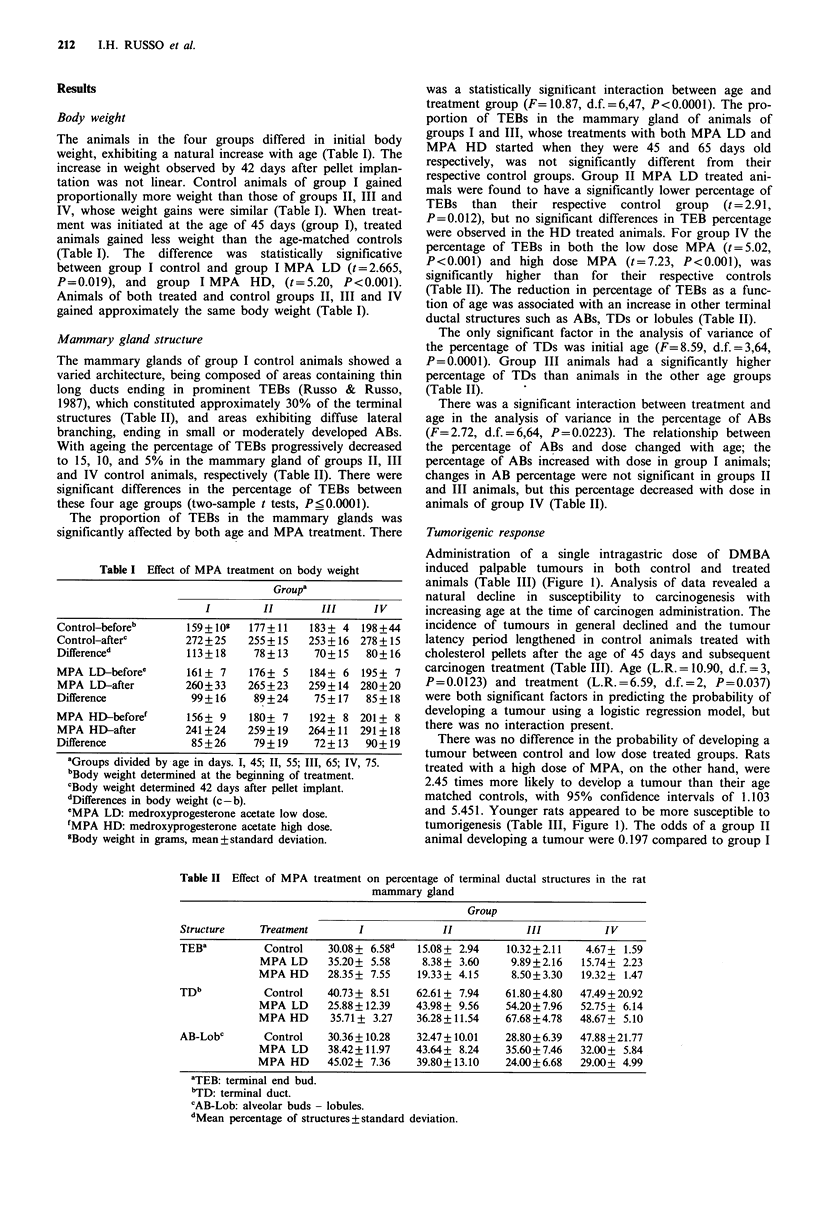
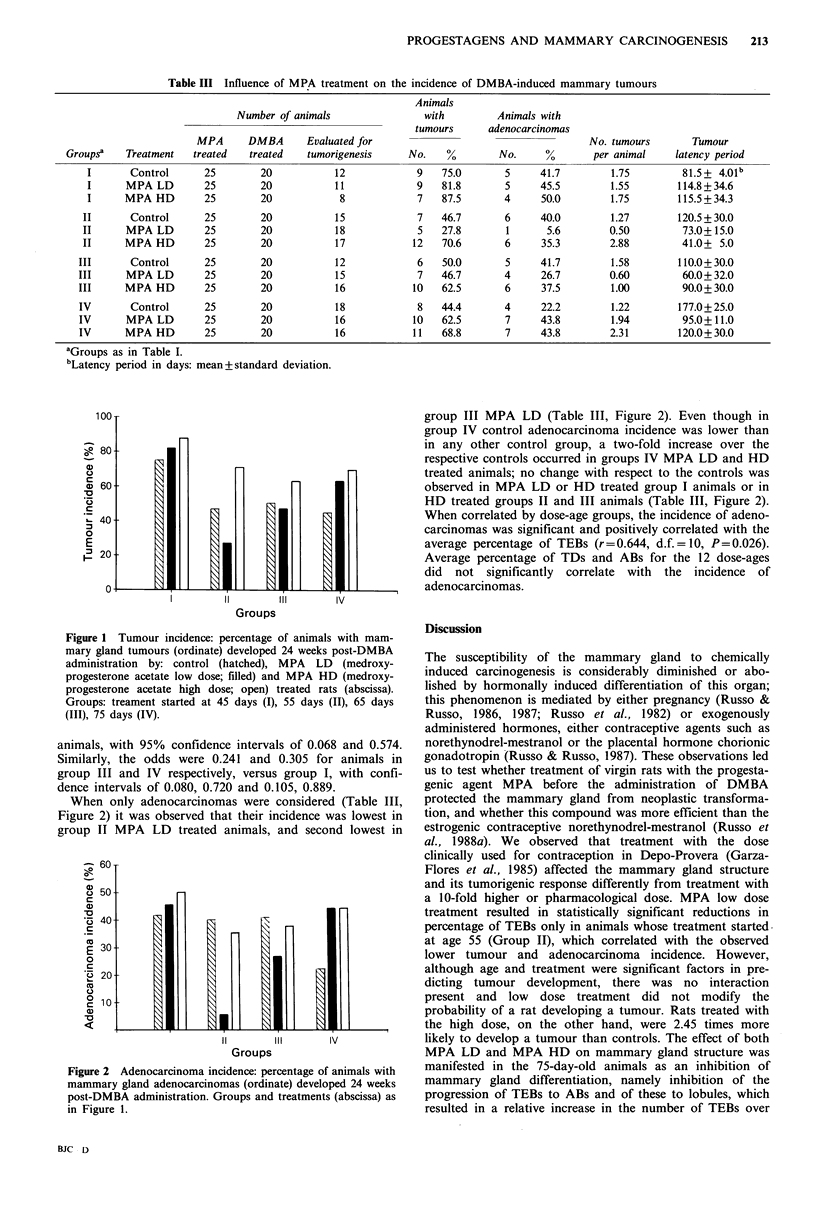
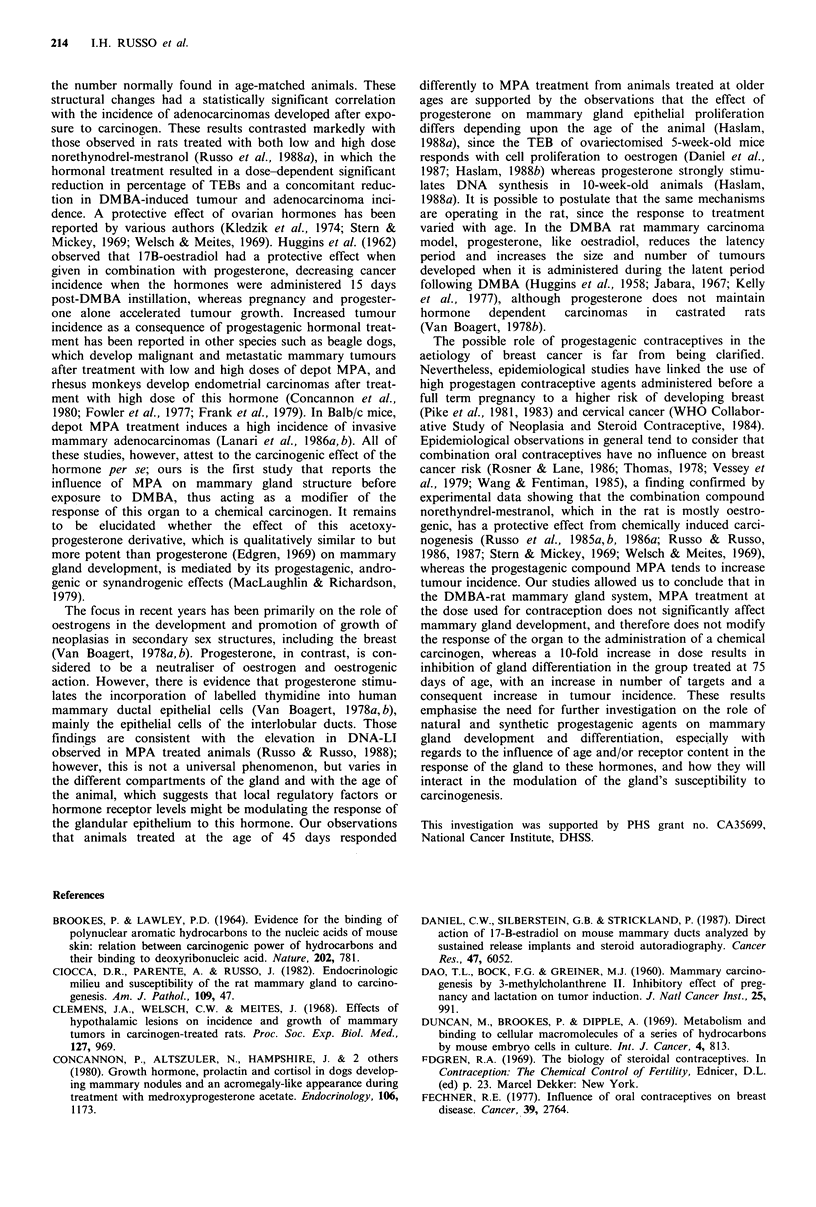
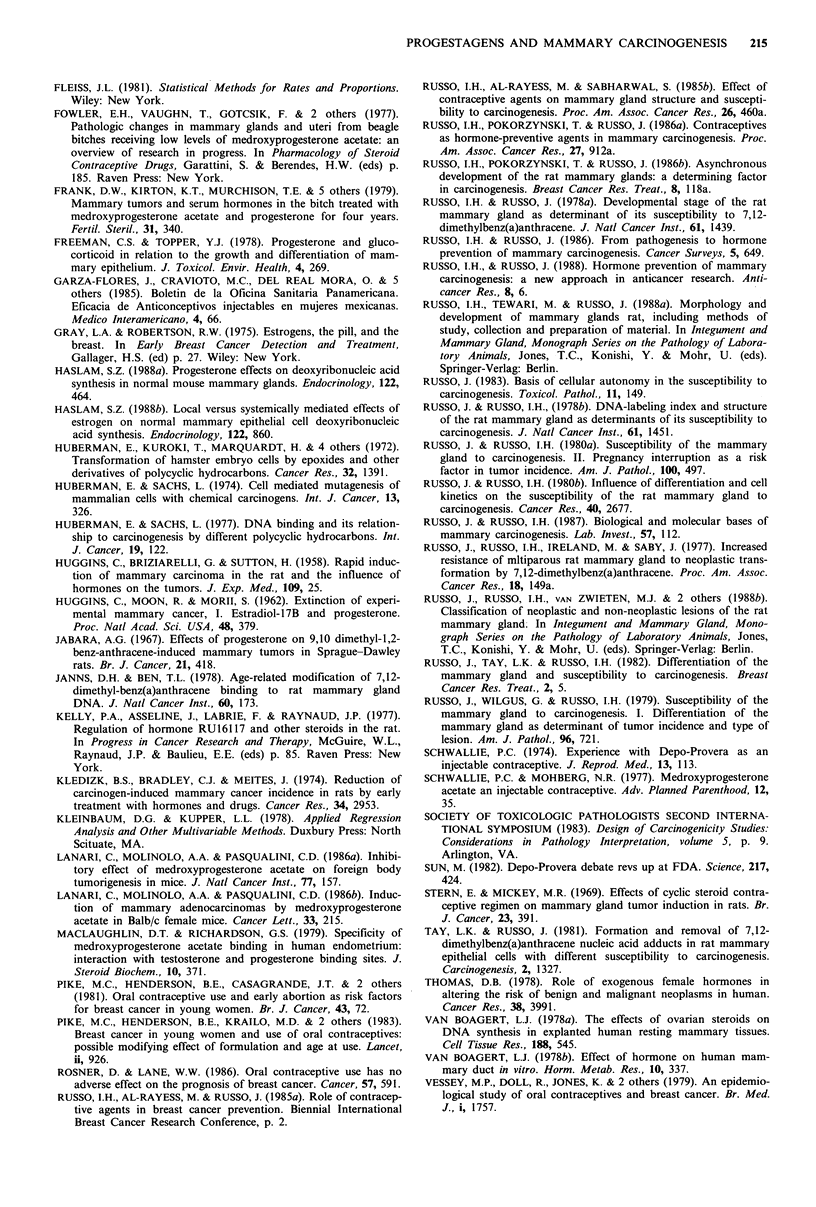
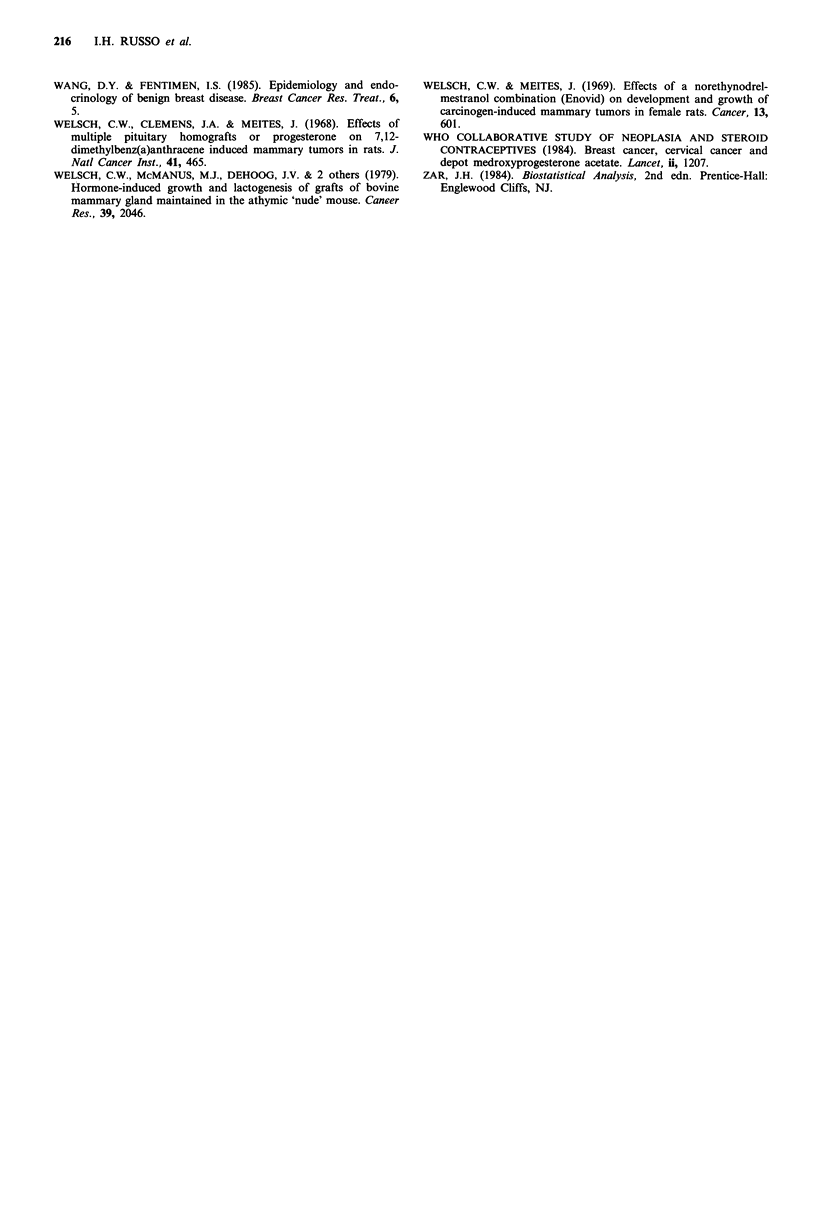
Selected References
These references are in PubMed. This may not be the complete list of references from this article.
- BROOKES P., LAWLEY P. D. EVIDENCE FOR THE BINDING OF POLYNUCLEAR AROMATIC HYDROCARBONS TO THE NUCLEIC ACIDS OF MOUSE SKIN: RELATION BETWEEN CARCINOGENIC POWER OF HYDROCARBONS AND THEIR BINDING TO DEOXYRIBONUCLEIC ACID. Nature. 1964 May 23;202:781–784. doi: 10.1038/202781a0. [DOI] [PubMed] [Google Scholar]
- Ciocca D. R., Parente A., Russo J. Endocrinologic milieu and susceptibility of the rat mammary gland to carcinogenesis. Am J Pathol. 1982 Oct;109(1):47–56. [PMC free article] [PubMed] [Google Scholar]
- Clemens J. A., Welsch C. W., Meites J. Effects of hypothalamic lesions on incidence and growth of mammary tumors in carcinogen-treated rats. Proc Soc Exp Biol Med. 1968 Mar;127(3):969–972. doi: 10.3181/00379727-127-32847. [DOI] [PubMed] [Google Scholar]
- Concannon P., Altszuler N., Hampshire J., Butler W. R., Hansel W. Grwoth hormone, prolactin, and cortisol in dogs developing mammary nodules and an acromegaly-like appearance during treatment with medroxyprogesterone acetate. Endocrinology. 1980 Apr;106(4):1173–1177. doi: 10.1210/endo-106-4-1173. [DOI] [PubMed] [Google Scholar]
- DAO T. L., BOCK F. G., GREINER M. J. Mammary carcinogenesis by 3-methylcholanthrene. II. Inhibitory effect of pregnancy and lactation on tumor induction. J Natl Cancer Inst. 1960 Nov;25:991–1003. [PubMed] [Google Scholar]
- Daniel C. W., Silberstein G. B., Strickland P. Direct action of 17 beta-estradiol on mouse mammary ducts analyzed by sustained release implants and steroid autoradiography. Cancer Res. 1987 Nov 15;47(22):6052–6057. [PubMed] [Google Scholar]
- Duncan M., Brookes P., Dipple A. Metabolism and binding to cellular macromolecules of a series of hydrocarbons by mouse embryo cells in culture. Int J Cancer. 1969 Nov 15;4(6):813–819. doi: 10.1002/ijc.2910040610. [DOI] [PubMed] [Google Scholar]
- Fechner R. E. Influence of oral contraceptives on breast diseases. Cancer. 1977 Jun;39(6 Suppl):2764–2771. doi: 10.1002/1097-0142(197706)39:6<2764::aid-cncr2820390664>3.0.co;2-i. [DOI] [PubMed] [Google Scholar]
- Frank D. W., Kirton K. T., Murchison T. E., Quinlan W. J., Coleman M. E., Gilbertson T. J., Feenstra E. S., Kimball F. A. Mammary tumors and serum hormones in the bitch treated with medroxyprogesterone acetate or progesterone for four years. Fertil Steril. 1979 Mar;31(3):340–346. doi: 10.1016/s0015-0282(16)43886-0. [DOI] [PubMed] [Google Scholar]
- Freeman C. S., Topper Y. J. Progesterone and glucocorticoid in relation to the growth and differentiation of mammary epithelium. J Toxicol Environ Health. 1978 Mar-May;4(2-3):269–282. doi: 10.1080/15287397809529661. [DOI] [PubMed] [Google Scholar]
- HUGGINS C., BRIZIARELLI G., SUTTON H., Jr Rapid induction of mammary carcinoma in the rat and the influence of hormones on the tumors. J Exp Med. 1959 Jan 1;109(1):25–42. doi: 10.1084/jem.109.1.25. [DOI] [PMC free article] [PubMed] [Google Scholar]
- HUGGINS C., MOON R. C., MORII S. Extinction of experimental mammary cancer. I. Estradiol-17beta and progesterone. Proc Natl Acad Sci U S A. 1962 Mar 15;48:379–386. doi: 10.1073/pnas.48.3.379. [DOI] [PMC free article] [PubMed] [Google Scholar]
- Haslam S. Z. Local versus systemically mediated effects of estrogen on normal mammary epithelial cell deoxyribonucleic acid synthesis. Endocrinology. 1988 Mar;122(3):860–867. doi: 10.1210/endo-122-3-860. [DOI] [PubMed] [Google Scholar]
- Haslam S. Z. Progesterone effects on deoxyribonucleic acid synthesis in normal mouse mammary glands. Endocrinology. 1988 Feb;122(2):464–470. doi: 10.1210/endo-122-2-464. [DOI] [PubMed] [Google Scholar]
- Huberman E., Kuroki T., Marquardt H., Selkirk J. K., Heidelberger C., Grover P. L., Sims P. Transformation of hamster embryo cells by epoxides and other derivatives of polycyclic hydrocarbons. Cancer Res. 1972 Jul;32(7):1391–1396. [PubMed] [Google Scholar]
- Huberman E., Sachs L. Cell-mediated mutagenesis of mammalian cells with chemical carcinogens. Int J Cancer. 1974 Mar 15;13(3):326–333. doi: 10.1002/ijc.2910130308. [DOI] [PubMed] [Google Scholar]
- Huberman E., Sachs L. DNA binding and its relationship to carcinogenesis by different polycyclic hydrocarbons. Int J Cancer. 1977 Jan;19(1):122–127. doi: 10.1002/ijc.2910190117. [DOI] [PubMed] [Google Scholar]
- Jabara A. G. Effects of progesterone on 9,10-dimethyl-1,2-benzanthracene-induced mammary tumours in Sprague-Dawley rats. Br J Cancer. 1967 Jun;21(2):418–429. doi: 10.1038/bjc.1967.48. [DOI] [PMC free article] [PubMed] [Google Scholar]
- Janss D. H., Ben T. L. Age-related modification of 7,12-dimethylbenz[a]anthracene binding to rat mammary gland DNA. J Natl Cancer Inst. 1978 Jan;60(1):173–177. doi: 10.1093/jnci/60.1.173. [DOI] [PubMed] [Google Scholar]
- Kledzik G. S., Bradley C. J., Meites J. Reduction of carcinogen-induced mammary cancer incidence in rats by early treatment with hormones or drugs. Cancer Res. 1974 Nov;34(11):2953–2956. [PubMed] [Google Scholar]
- Lanari C., Molinolo A. A., Pasqualini C. D. Induction of mammary adenocarcinomas by medroxyprogesterone acetate in BALB/c female mice. Cancer Lett. 1986 Nov;33(2):215–223. doi: 10.1016/0304-3835(86)90027-3. [DOI] [PubMed] [Google Scholar]
- Lanari C., Molinolo A. A., Pasqualini C. D. Inhibitory effect of medroxyprogesterone acetate on foreign body tumorigenesis in mice. J Natl Cancer Inst. 1986 Jul;77(1):157–164. [PubMed] [Google Scholar]
- MacLaughlin D. T., Richardson G. S. Specificity of medroxyprogesterone acetate binding in human endometrium: interaction with testosterone and progesterone binding sites. J Steroid Biochem. 1979 Apr;10(4):371–377. doi: 10.1016/0022-4731(79)90322-4. [DOI] [PubMed] [Google Scholar]
- Pike M. C., Henderson B. E., Krailo M. D., Duke A., Roy S. Breast cancer in young women and use of oral contraceptives: possible modifying effect of formulation and age at use. Lancet. 1983 Oct 22;2(8356):926–930. doi: 10.1016/s0140-6736(83)90450-6. [DOI] [PubMed] [Google Scholar]
- Rosner D., Lane W. W. Oral contraceptive use has no adverse effect on the prognosis of breast cancer. Cancer. 1986 Feb 1;57(3):591–596. doi: 10.1002/1097-0142(19860201)57:3<591::aid-cncr2820570333>3.0.co;2-q. [DOI] [PubMed] [Google Scholar]
- Russo I. H., Russo J. Developmental stage of the rat mammary gland as determinant of its susceptibility to 7,12-dimethylbenz[a]anthracene. J Natl Cancer Inst. 1978 Dec;61(6):1439–1449. [PubMed] [Google Scholar]
- Russo I. H., Russo J. From pathogenesis to hormone prevention of mammary carcinogenesis. Cancer Surv. 1986;5(3):649–670. [PubMed] [Google Scholar]
- Russo J. Basis of cellular autonomy in the susceptibility to carcinogenesis. Toxicol Pathol. 1983;11(2):149–166. doi: 10.1177/019262338301100207. [DOI] [PubMed] [Google Scholar]
- Russo J., Russo I. H. Biological and molecular bases of mammary carcinogenesis. Lab Invest. 1987 Aug;57(2):112–137. [PubMed] [Google Scholar]
- Russo J., Russo I. H. DNA labeling index and structure of the rat mammary gland as determinants of its susceptibility to carcinogenesis. J Natl Cancer Inst. 1978 Dec;61(6):1451–1459. [PubMed] [Google Scholar]
- Russo J., Russo I. H. Influence of differentiation and cell kinetics on the susceptibility of the rat mammary gland to carcinogenesis. Cancer Res. 1980 Aug;40(8 Pt 1):2677–2687. [PubMed] [Google Scholar]
- Russo J., Russo I. H. Susceptibility of the mammary gland to carcinogenesis. II. Pregnancy interruption as a risk factor in tumor incidence. Am J Pathol. 1980 Aug;100(2):497–512. [PMC free article] [PubMed] [Google Scholar]
- Russo J., Tay L. K., Russo I. H. Differentiation of the mammary gland and susceptibility to carcinogenesis. Breast Cancer Res Treat. 1982;2(1):5–73. doi: 10.1007/BF01805718. [DOI] [PubMed] [Google Scholar]
- Russo J., Wilgus G., Russo I. H. Susceptibility of the mammary gland to carcinogenesis: I Differentiation of the mammary gland as determinant of tumor incidence and type of lesion. Am J Pathol. 1979 Sep;96(3):721–736. [PMC free article] [PubMed] [Google Scholar]
- Schwallie P. C. Experience with Depo-provera as an injectable contraceptive. J Reprod Med. 1974 Sep;13(3):113–117. [PubMed] [Google Scholar]
- Stern E., Mickey M. R. Effects of a cyclic steroid contraceptive regimen on mammary gland tumor induction in rats. Br J Cancer. 1969 Jun;23(2):391–400. doi: 10.1038/bjc.1969.51. [DOI] [PMC free article] [PubMed] [Google Scholar]
- Sun M. Depo-Provera debate revs up at FDA. Science. 1982 Jul 30;217(4558):424–428. doi: 10.1126/science.6211767. [DOI] [PubMed] [Google Scholar]
- Tay L. K., Russo J. Formation and removal of 7,12-dimethylbenz[a]anthracene--nucleic acid adducts in rat mammary epithelial cells with different susceptibility to carcinogenesis. Carcinogenesis. 1981;2(12):1327–1333. doi: 10.1093/carcin/2.12.1327. [DOI] [PubMed] [Google Scholar]
- Thomas D. B. Role of exogenous female hormones in altering the risk of benign and malignant neoplasms in humans. Cancer Res. 1978 Nov;38(11 Pt 2):3991–4000. [PubMed] [Google Scholar]
- Vessey M. P., Doll R., Jones K., McPherson K., Yeates D. An epidemiological study of oral contraceptives and breast cancer. Br Med J. 1979 Jun 30;1(6180):1757–1760. doi: 10.1136/bmj.1.6180.1757. [DOI] [PMC free article] [PubMed] [Google Scholar]
- Wang D. Y., Fentiman I. S. Epidemiology and endocrinology of benign breast disease. Breast Cancer Res Treat. 1985;6(1):5–36. doi: 10.1007/BF01806008. [DOI] [PubMed] [Google Scholar]
- Welsch C. W., Clemens J. A., Meites J. Effects of multiple pituitary homografts or progesterone on 7,12-dimethylbenz[a]anthracene-induced mammary tumors in rats. J Natl Cancer Inst. 1968 Aug;41(2):465–471. [PubMed] [Google Scholar]
- Welsch C. W., McManus M. J., DeHoog J. V., Goodman G. T., Tucker H. A. Hormone-induced growth and lactogensis of grafts of bovine mammary gland maintained in the athymic "nude" mouse. Cancer Res. 1979 Jun;39(6 Pt 1):2046–2050. [PubMed] [Google Scholar]
- Welsch C. W., Meites J. Effects of a norethynodrel-mestranol combination (enovid) on development and growth of carcinogen-induced mammary tumors in female rats. Cancer. 1969 Mar;23(3):601–607. doi: 10.1002/1097-0142(196903)23:3<601::aid-cncr2820230312>3.0.co;2-x. [DOI] [PubMed] [Google Scholar]
- van Bogaert L. J. Effect of hormone on human mammary duct in vitro. Horm Metab Res. 1978 Jul;10(4):337–340. doi: 10.1055/s-0028-1093426. [DOI] [PubMed] [Google Scholar]
- van Bogaert L. J. Effect of ovarian steroids on DNA synthesis in explanted human adult resting mammary tissues. Cell Tissue Res. 1978 Apr 28;188(3):545–550. doi: 10.1007/BF00219791. [DOI] [PubMed] [Google Scholar]


